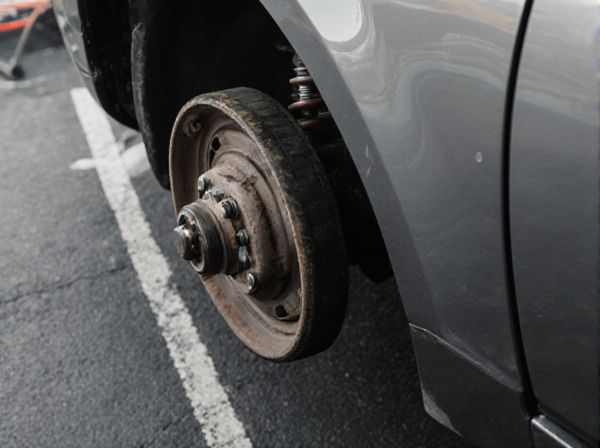
Photo illustration: Steering Damper vs No Damper
A steering damper significantly enhances stability by reducing unwanted handlebar vibrations and wobble, especially at high speeds or on rough terrain. Without a damper, your steering may feel loose or twitchy, increasing the risk of loss of control and rider fatigue. Installing a steering damper improves safety and comfort by providing smoother, more controlled steering feedback.
Table of Comparison
| Feature | Steering Damper | No Damper |
|---|---|---|
| Steering Stability | Improves stability by reducing handlebar oscillations | Less stable; prone to wobbling or shaking at high speeds |
| Vibration Absorption | Absorbs road vibrations for smoother steering | Direct transfer of vibrations to hands and arms |
| Safety | Enhances control, reducing risk of loss of control | Higher risk of sudden handlebar movement causing accidents |
| Maintenance | Requires periodic checks and possible fluid replacement | Minimal maintenance related to steering system |
| Cost | Additional cost for purchase and maintenance | No extra cost |
| Performance on Rough Terrain | Significantly reduces handlebar feedback for better control | More feedback, which can be tiring and less controlled |
What Is a Steering Damper?
A steering damper is a shock-absorbing device mounted on motorcycles or bicycles to reduce unwanted handlebar oscillations, known as "speed wobbles" or "tank slappers." It stabilizes the front end by controlling steering feedback and vibration, improving rider control and safety at high speeds or on rough terrain. Without a steering damper, riders may experience increased handlebar instability, which can lead to fatigue and potential loss of control.
How Steering Dampers Work
Steering dampers function by absorbing and dissipating unwanted oscillations and vibrations in the steering system, using hydraulic fluid or springs to stabilize the handlebars. Without a steering damper, motorcycles or bicycles are prone to experiencing "headshake," especially at higher speeds or on rough terrain, which can compromise control and safety. The damper's resistance mechanism smooths out sudden steering inputs and reduces feedback from uneven surfaces, enhancing overall stability and rider confidence.
Riding Experience: With vs Without a Damper
A steering damper significantly enhances riding stability by reducing handlebar vibrations and preventing sudden, uncontrollable movements, especially at high speeds or on rough terrains. Without a damper, riders often experience increased front-end wobble and fatigue due to constant corrective inputs, which can compromise safety and comfort. The presence of a damper delivers smoother steering response, resulting in improved confidence and control during various riding conditions.
Handling and Stability Comparison
Steering dampers significantly enhance handling by reducing front-end oscillations and counteracting sudden steering inputs, resulting in improved stability at high speeds and rough terrains. Motorcycles without dampers frequently experience increased wobble and twitchiness, especially under challenging riding conditions, making control more difficult. Choosing a steering damper optimizes trajectory control and rider confidence, especially in aggressive or off-road riding scenarios.
Safety Implications of Using a Steering Damper
Using a steering damper significantly enhances motorcycle stability by reducing handlebar oscillations and preventing uncontrollable wobble at high speeds, directly improving safety. Riders experience increased control during abrupt maneuvers and over uneven terrain, minimizing the risk of accidents caused by sudden steering inputs or road irregularities. Without a damper, the likelihood of front-end instability rises, especially on powerful or off-road bikes, potentially leading to dangerous loss of control.
Advantages of Riding Without a Damper
Riding without a steering damper offers increased feedback and direct connection to the road, enhancing rider control and responsiveness during aggressive maneuvers or off-road conditions. The absence of a damper reduces weight and mechanical complexity, contributing to a lighter front end and easier handling at low speeds. This setup is often preferred by experienced riders who value uninterrupted steering feel and natural front suspension behavior.
Drawbacks of Not Using a Steering Damper
Not using a steering damper can lead to increased handlebar vibration and reduced stability, especially at high speeds or on rough terrain. This absence often results in greater rider fatigue and difficulty maintaining control, heightening the risk of accidents. Bikes without steering dampers are more prone to front-end wobble and tank slappers, compromising overall safety and handling precision.
Best Situations for Installing a Steering Damper
Steering dampers are best installed on motorcycles or dirt bikes used for off-road riding or high-speed stability to reduce handlebar vibrations and prevent tank slappers. Bikes with large front wheels or heavy fairings benefit from steering dampers to improve control in rough terrain or windy conditions. Riders tackling aggressive trails, long-distance touring, or high-performance racing will experience enhanced safety and comfort by adding a properly tuned steering damper.
Common Myths About Steering Dampers
Steering dampers are often misunderstood, with common myths suggesting they are only necessary for off-road motorcycles or high-performance bikes, whereas they provide stability and reduce handlebar vibrations on various motorcycle types. Some riders believe steering dampers impair steering responsiveness, but properly tuned dampers enhance control without sacrificing agility. The misconception that steering dampers are a fix for poor suspension or frame issues overlooks their primary role in minimizing front-end oscillations and improving rider confidence.
Final Verdict: Do You Need a Steering Damper?
A steering damper significantly improves stability by reducing handlebar oscillations, especially at high speeds or on rough terrain, making it essential for off-road motorcycles and sportbikes. Riders who frequently encounter vibrations, potholes, or aggressive cornering benefit from the enhanced control and safety provided by a damper. For casual riders on smooth roads, the absence of a damper may not impact performance notably, but for optimal handling and prevention of speed wobbles, installing a steering damper is highly recommended.
 caratoz.com
caratoz.com